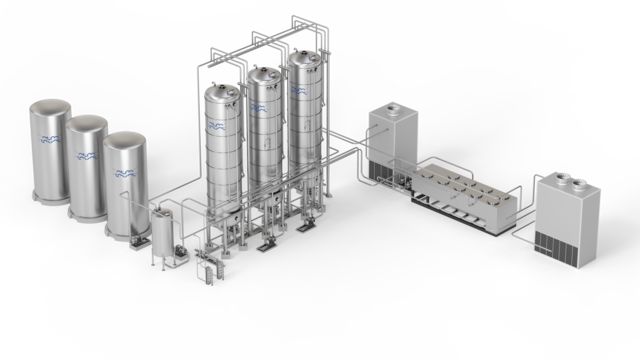Fat modification process systems
Moving from refined oils to speciality fats? Or extending your existing facilities to handle specialty fats? Alfa Laval has a full range of fat modification processes such as fat hardening, interesterification (chemical or enzymatic), dry fractionation and semi-continuous deodorization. These can be integrated with an upstream refinery, work as a stand-alone process, or supply feedstock to downstream facilities such as margarine or shortening lines.
Benefits of our fat modification equipment
- Flexible design to handle a high number of production of different speciality fats per day
- Equipment can be designed for multiple purposes
- Minimal use of water and energy
Alfa Laval has simplified dry fractionation into a process that is easy for the operator to interface, and thus transformed the technology,” - Kenny Liew, Deputy Plant Manager for IOI Edible Oils Sdn Bhd in Malaysia.
Alfa Laval supplied us with a highly efficient plant, with the lowest production costs in terms of energy, hydrogen and catalyst consumption. It gives us unlimited flexibility to produce any type of fats we want,” - Alejandro Murillo, plant manager of CALSA – Cia Argentina de Levaduras S.A.I.C. – Argentina.
Process design for any speciality fats portfolio
Depending on the products your customers are interested in and the raw materials you have available, you can choose between several different Alfa Laval solutions, or a combination of these.
Fractionation process
 The natural way to modify oils and fats
The natural way to modify oils and fats
If your feedstock stems from palm oil or animal fats, there is a direct, natural way to modify it to ensure that it acquires greater value. By separating the feedstock into liquid and solid fractions, or by combining different fractions, you can create products that match your customers’ exact specifications. Fractionation consists of gently cooling oils or fats in an accurately controlled process, making it possible to crystallize the hard fat content. In dry fractionation, the fat is kept at a temperature at which it is in a partially liquid form. The crystals are then separated from the liquid fraction by membrane filtration. The result is two distinct products with different physical properties and melting points. This can be achieved with absolutely no chemical modification, making this the “natural” way to produce hard fats.
Hydrogenation process
 The versatile way to modify fats
The versatile way to modify fats
Oils and fats from virtually all kinds of raw materials and ingredients can be modified into hard fats by altering their molecular structure. This is done by hydrogenation – the name given to the process in which hydrogen is chemically combined with unsaturated oils and fats, by making it link up with the double bonds of the unsaturated fatty acid chains. Essentially, this process consists of bubbling hydrogen gas through the oils, normally at temperatures of 150–200°C (302–392°F), under pressure and in the presence of a catalyst. This adds the hydrogen atoms to the double bonds of unsaturated fatty acids, either to reduce them or to produce fully saturated fats. Hydrogenation raises the melting point of oils and fats and improves a range of other properties, including taste and shelflife qualities. The diagrams to the right and below show two systems based on filtration and continuous centrifugal separation that Alfa Laval provides for catalyst removal.
Interesterification process
Want to combine an efficient, flexible production set-up with the ability to satisfy ever-changing customer demands? Interesterification can help.
By combining different oils and fats, interesterification makes it possible to produce hard fats from a wide range of raw materials – and in a way that conforms to modern market demands.
Traditional interesterification is carried out by using a chemical catalyst (normally sodium methylate) to bring about a regrouping of the position of the fatty acids on the basic glycerol molecule.
The mixture of oils and fats is pumped from the mixing tank to a steam heater and then to the reactor under vacuum conditions for drying. To improve drying efficiency, the oil is pumped through a recirculation section.
After drying the oil, a catalyst is introduced into the oil recirculation stream, using the special catalyst dosing device. When the catalyst reaction is completed, the oil is discharged to the post-treatment reactor. Here, the catalyst is deactivated with acid and the oil is treated using bleaching earth.
As an alternative, the catalyst can be deactivated with water in the washing tank. The soap generated in this process is removed using a disc stack centrifuge. The oil is then dried and sent to the post-treatment stage.
Interesterification does not affect the degree of saturation of the fat, nor the location of the cis-trans chemical bonds. It is largely done to control the consistency of the oil or fat at different temperatures, a parameter that is crucial for your customers in the food industry.
Customer's voice
IOI Edible Oils
The Alfa Laval dry fractionation plant at the palm oil refinery run by IOI Edible Oils features six crystallizers and one filter press. Here, dry fractionation is more than just a way of producing cooking oil. Advanced PLC systems have been added for efficient control and top-quality results.
Alfa Laval has simplified dry fractionation into a process that is easy for the operator to interface, and thus transformed the technology,”
- Kenny Liew, Deputy Plant Manager
CALSA – Cia Argentina de Levaduras S.A.I.C
The Alfa Laval hydrogenation plant supplied to CALSA features a feed tank, a drop tank and a dead-end reactor. Heat recovery is done by a highly efficient plate heat exchanger. Catalyst removal is undertaken in two steps, using direct filtration followed by a post-treatment system. The plant is fully automatic, controlled by a PLC unit.
Alfa Laval supplied us with a highly efficient plant, with the lowest production costs in terms of energy, hydrogen and catalyst consumption. It gives us unlimited flexibility to produce any type of fats we want,”
- Alejandro Murillo, Plant Manager of CALSA, Argentina.
Let us help
Optimize your fat modifications process system based on the oils readily available and your market opportunities. Feel free to contact us at any time – even during the early stages – and take advantage of our extensive experience. We are eager to work with you to maximize the value from speciality fats production.
Webinar for the Edible Oil industry
Our experts share know-how to optimize edible oil refining processes, remove impurities and volatile components for better product quality, safety and yield.



